
Concept explainers
(a)
Interpretation:
The synthesis of given compound from the given starting material is to be stated.
Concept Introduction:
Organolithium compounds can be formed by the reaction of
Answer:
The synthesis of given compound from given starting material is shown below.

Explanation:
The given compound
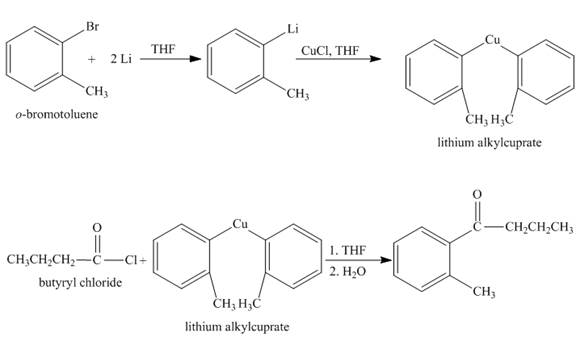
Figure 1
Conclusion:
The synthesis of given compound is shown in Figure 1.
Answer to Problem 21.56AP
The synthesis of given compound from given starting material is shown below.

Explanation of Solution
The given compound

Figure 1
The synthesis of given compound is shown in Figure 1.
(b)
Interpretation:
The synthesis of given compound from the given starting material is to be stated.
Concept Introduction:
Grignard reagent is formed when alkyl halide compound reacts with magnesium in presence of ether. Potassium dichromate is a strong oxidizing agent. It can easily oxidize alcohol group to carboxylic acid group. The reaction of carboxylic acid with alcohol results in the formation of ester.
Answer to Problem 21.56AP
The synthesis of given compound from given starting material is shown below.
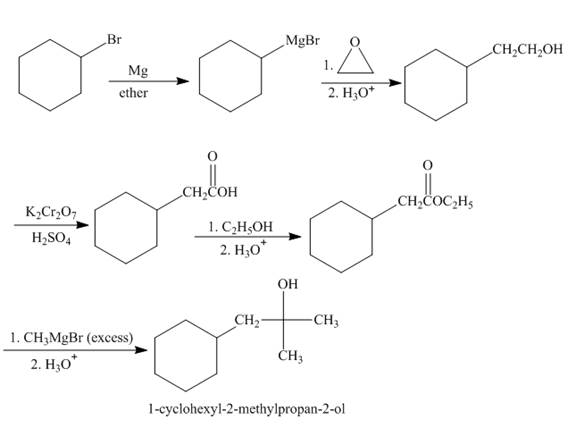
Explanation of Solution
Bromocyclohexane when reacted with magnesium in the ether, it will form grignard reagent. Then grignard reagent will react with
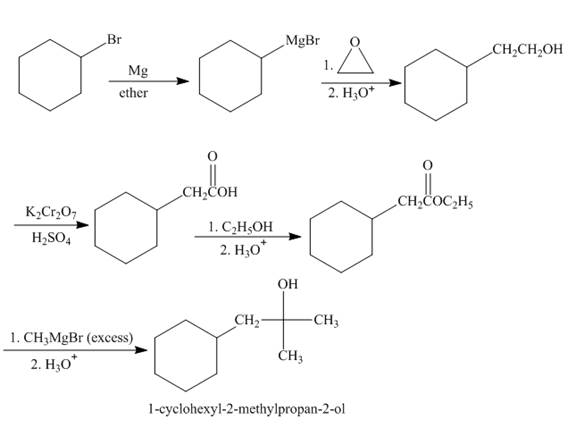
Figure 2
The synthesis of given compound is shown in Figure 2.
(c)
Interpretation:
The synthesis of given compound from the given starting material is to be stated.
Concept Introduction:
The carboxylic acid compound reacts with ammonia to form the amide compound. The carbonyl carbon of acid is electrophilic in nature and the lone pair of nitrogen atom of ammonia acts as nucleophile. They will undergo the nucleophilic substitution reaction. Lithium aluminium hydride is a strong reducing agent.
Answer to Problem 21.56AP
The synthesis of given compound from given starting material is shown below.
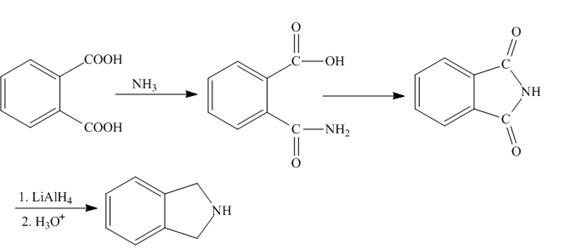
Explanation of Solution
The phthalic acid reacts with ammonia, the lone pair of ammonia nitrogen attacks the carbonyl carbon atom and then with the removal of water molecule phthalamic acid is formed. Then phthalamic acid undergoes cyclization reaction to form phthalamide. Phthalamide upon reduction with lithium aluminium hydride e form the desired product. The synthesis of the given compound is shown below.
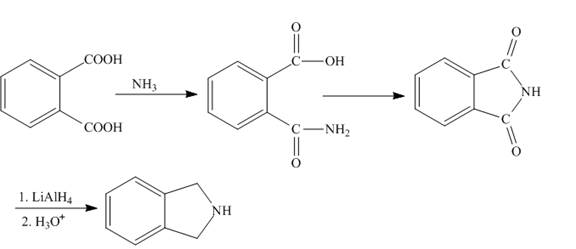
Figure 3
The synthesis of given compound is shown in Figure 3.
(d)
Interpretation:
The synthesis of given compound from the given starting material is to be stated.
Concept Introduction:
Acid can be converted into acid chloride by the reaction of acid with
Answer to Problem 21.56AP
The synthesis of given compound from given starting material is shown below.

Explanation of Solution
The isovaleric acid reacts with

Figure 4
The synthesis of given compound is shown in Figure 4.
(e)
Interpretation:
The synthesis of given compound from the given starting material is to be stated.
Concept Introduction:
Sodium borohyride is a reducing agent. It reduces the
Answer to Problem 21.56AP
The synthesis of given compound from given starting material is shown below.
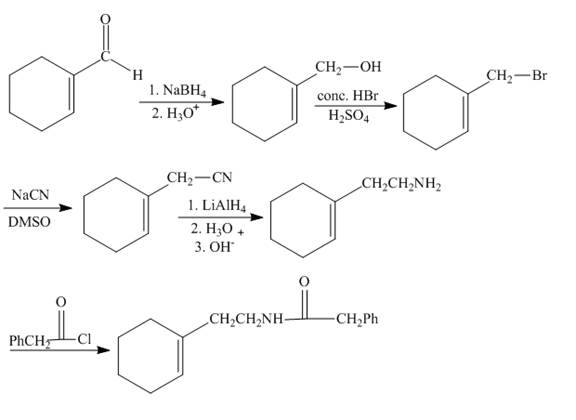
Explanation of Solution
The given starting material reacts with sodium borohydride to convert the carbonyl group into the alcohol group. The reaction of alcohol with hydrogen bromide forms bromoalkene compound. Bromoalkene reacts with the sodium cyanide to form nitrile compound. The nitrile upon reduction forms amine. The amine functional group when reacts with the acid chloride it forms the amide. The synthesis is shown below.

Figure 5
The synthesis of given compound is shown in Figure 5.
(f)
Interpretation:
The synthesis of given compound from the given starting material is to be stated.
Concept Introduction:
Cyanohydrin can be formed on reaction of ketone with cyanide. It is a nucleophilic addition reaction. The cyanide ion acts as nucleophile and carbonyl carbon is electrophile. Nitrile group can be converted into amine by reduction with lithium aluminium hydride.
Answer to Problem 21.56AP
The synthesis of given compound from given starting material is shown below.

Explanation of Solution
Ketones react with the hydrogen cyanide to form cyanohydrin. The cyanide ion acts as the nucleophile and attacks the electrophilic carbon of the carbonyl group. The cyano hydrin formed will undergo reduction in presence of lithium aluminium hydride to reduce the cyanide group to amine group. The synthesis of the given compound is shown below.

Figure 6
The synthesis of given compound is shown in Figure 6.
(g)
Interpretation:
The synthesis of given compound from the given starting material is to be stated.
Concept Introduction:
Nitration reaction is the reaction in which nitro derivatives are formed. The mixture of nitric acid and sulfuric acid is used as the nitrating mixture. Benzoic acid upon nitration form meta nitrobenzoic acid. The reaction of carboxylic acid with sodium hydroxide produces sodium salt of carboxylic acid.
Answer to Problem 21.56AP
The synthesis of given compound is shown below.
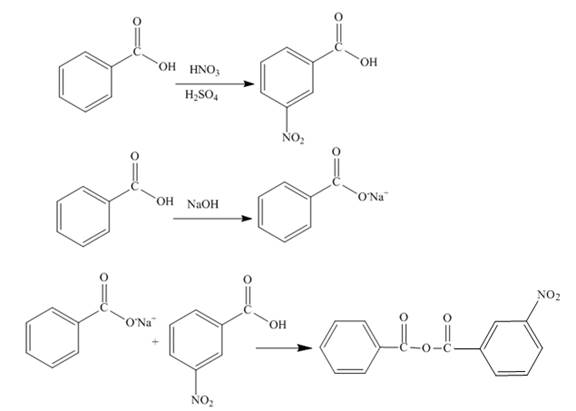
Explanation of Solution
The benzoic acid undergoes nitration reaction in presence of nitric acid and sulfuric acid. The meta product is formed upon nitration of benzoic acid. The meta-nitrobenzoic acid is formed on nitration of benzoic acid. Sodium salt of benzoic acid is formed when benzoic acid reacts with sodium hydroxide. The reaction between the meta-nitrobenzoic acid and sodium salt of benzoic acid forms the desired product. The synthesis of the given compound is shown below.

Figure 7
The synthesis of given compound is shown in Figure 7.
(h)
Interpretation:
The synthesis of given compound from the given starting material is to be stated.
Concept Introduction:
Acid can be converted into acid chloride by the reaction of acid with
Answer to Problem 21.56AP
The synthesis of given compound is shown below.

Explanation of Solution
The carboxylic acid group is converted into the acid chloride group by reaction of acid with thionyl chloride. Acid chloride undergoes catalytic reduction to form aldehyde group. Methyl magnesiumbromide converted the product into alkylated secondary alcohol. The formed hydroxy ester compound undergoes cyclization reaction to form the lactone. The synthesis of the given compound is shown below.

Figure 8
The synthesis of given compound is shown in Figure 8.
(i)
Interpretation:
The synthesis of given compound from the given starting material is to be stated.
Concept Introduction:
Potassium permanganate is a strong oxidizing agent. It will oxidize the alkyl group directly to the carboxylic acid group. Thionyl chloride is used for chlorinating the carboxylic acid group. Acid chloride and amines reacts to form the amide linkage.
Answer to Problem 21.56AP
The synthesis of given compound is shown below.

Explanation of Solution
The compound,

Figure 9
The synthesis of given compound is shown in Figure 9.
(j)
Interpretation:
The synthesis of given compound from the given starting material is to be stated.
Concept Introduction:
Chloro formic esters and carbonates are formed when phosgene reacts with alcohol compounds. The carbon of phosgene is electrophilic in nature. The phosgene reacts with alcohol and amines. Lone pair of oxygen atom in the alcohol compounds acts as the nucleophilie. Thus nucleophilic substitution reaction can occur.
Answer to Problem 21.56AP
The synthesis of given compound is shown below.

Explanation of Solution
Phosgene has an electrophilic carbon centre. The lone pair of oxygen atom of alcohol acts as nucleophile and attacks at the electrophilic carbon of phosgene. Chloride ion acts as the leaving group. The phosgene reacts with methanol to form methyl chloroformate. Then methyl chloroformate reacts with phenol to form the methyl phenyl carbonate. The complete synthesis is shown below.

Figure 10
The
(k)
Interpretation:
The synthesis of given compound from the given starting material is to be stated.
Concept Introduction:
The formation of biaryls by the coupling of aryl halides is known as Ullmann reaction. The reaction takes place in the presence of copper. The reaction proceeds via radical mechanism. The thoinyl chloride reacts with acid to form acid chloride. Potassium permangenate is a strong oxidizing agent which convert alkyl group directly into acid group.
Answer to Problem 21.56AP
The synthesis of given organic compound is shown below.

Explanation of Solution
The

Figure 11
The synthesis of given compound is shown in Figure 11.
Want to see more full solutions like this?
Chapter 21 Solutions
ORGANIC CHEMISTRY (LL)+ SAPLING ACC >BI
- Outline the synthesis of racemic 3-methyl-3-heptanol, Et(Me)C(*)OHn-Bu, starting from alcohols of four carbons or fewer and any inorganic reagents or solvent needed.arrow_forwardStearolic acid, C18H32O2, yields stearic acid on catalytic hydrogenation and undergoes oxidative cleavage with ozone to yield nonanoic acid and nonanedioic acid. What is the structure of stearolic acid?arrow_forwardWolff-Kishner reduction of compound W gave compound A. Treatment of A with m-chloroperbenzoic acid gave B which on reduction with LiAH4 gave C. Oxidation of compound C with chromic acid gave D (C9H14O). Suggest the structures for A, B, C, and D.arrow_forward
- Compound A is an alcohol that undergoes oxidation to produce compound B.Compound B is a ketone that gives positive triiodomethane reaction. Compound B isthen reacted with phenyl magnesium bromide, C6H5MgBr in the presence of aqueousacid to form compound C. Compound C has the molecular formula of C9H12O. Deducethe structure for compound A, B and C. PLEASE PROVIDE CLEAR DRAWINGS AND EXPLANATIONSarrow_forwardSuggest the reagents for the synthesis of the following compoundsarrow_forwardA hydrocarbon (X), with the molecular formula: C8H14 is reduced in presence of sodium and liquid ammonia to give the only product (Y) with the molecular formula: C8H16. Compounds X and Y both resulting 2,5-dimethylhexane when treated with hydrogen and platinum catalyst (H2/Pt). As a result of the oxidative cleavage of compound Y (by using KMnO4 / H2SO4), a single carboxylic acid derivative with C4H8O2 molecular formula is formed. Again, as a result of the reaction of Y with perbenzoic acid, the chiral compound C8H14O is observed, but the reaction of compound Y with bromine gives the achiral C8H14Br2 as the product.arrow_forward
- Provide the synthesis of 2-bromo-4-nitrophenyl from aniline. (structures). With explanation need.arrow_forwardEstablish the reaction and propose a mechanism for the reaction of benzene with bromine catalyzed with ferric bromidearrow_forwardAn unknown hydrocarbon G, whose formula is C16H26 contains two triple bonds. Ozonolysis followed by reduction with (CH3)2S gave CH3(CH2)4CO2H and HO2CCH2CH2CO2H as the only products. Suggest a reasonable structure for compound G.arrow_forward
- Outline a synthesis of each of the following compounds from isopropyl alcohol. A compound prepared in one part can be used as a reactant in another. (Hint: which of the compounds shown can serve as a starting material to all others?)arrow_forwardOn being heated with a solution of sodium ethoxide in ethanol, compound A (C7H15Br) yielded a mixture of two alkenes B and C, each having the molecular formula C7H14. Catalytic hydrogenation of the major isomer B or the minor isomer C gave only 3-ethylpentane. Suggest structures for compounds A, B, and C consistent with these observations.arrow_forward(a) suggest the suitable mechanism and illustrate the stepwise of the (heptyloxy)cyclopentane mechanism. (b) illustrate, and write the mechanism the formation of iodocyclopentane and 1-iodoheptane.arrow_forward
 ChemistryChemistryISBN:9781305957404Author:Steven S. Zumdahl, Susan A. Zumdahl, Donald J. DeCostePublisher:Cengage Learning
ChemistryChemistryISBN:9781305957404Author:Steven S. Zumdahl, Susan A. Zumdahl, Donald J. DeCostePublisher:Cengage Learning ChemistryChemistryISBN:9781259911156Author:Raymond Chang Dr., Jason Overby ProfessorPublisher:McGraw-Hill Education
ChemistryChemistryISBN:9781259911156Author:Raymond Chang Dr., Jason Overby ProfessorPublisher:McGraw-Hill Education Principles of Instrumental AnalysisChemistryISBN:9781305577213Author:Douglas A. Skoog, F. James Holler, Stanley R. CrouchPublisher:Cengage Learning
Principles of Instrumental AnalysisChemistryISBN:9781305577213Author:Douglas A. Skoog, F. James Holler, Stanley R. CrouchPublisher:Cengage Learning Organic ChemistryChemistryISBN:9780078021558Author:Janice Gorzynski Smith Dr.Publisher:McGraw-Hill Education
Organic ChemistryChemistryISBN:9780078021558Author:Janice Gorzynski Smith Dr.Publisher:McGraw-Hill Education Chemistry: Principles and ReactionsChemistryISBN:9781305079373Author:William L. Masterton, Cecile N. HurleyPublisher:Cengage Learning
Chemistry: Principles and ReactionsChemistryISBN:9781305079373Author:William L. Masterton, Cecile N. HurleyPublisher:Cengage Learning Elementary Principles of Chemical Processes, Bind...ChemistryISBN:9781118431221Author:Richard M. Felder, Ronald W. Rousseau, Lisa G. BullardPublisher:WILEY
Elementary Principles of Chemical Processes, Bind...ChemistryISBN:9781118431221Author:Richard M. Felder, Ronald W. Rousseau, Lisa G. BullardPublisher:WILEY





